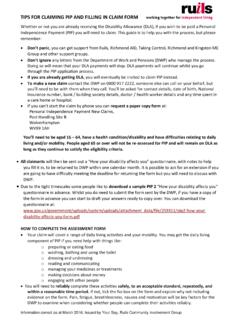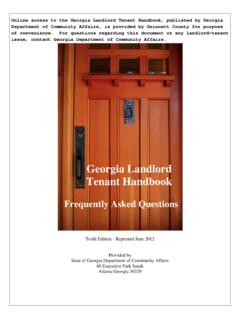Transcription of Designing Gypsy and Traveller Sites - GOV.UK
1 Designing Gypsy and Traveller SitesGood Practice , opportunity, prosperityDesigning Gypsy and Traveller SitesGood Practice GuideMay 2008 Department for Communities and Local GovernmentCommunities and Local Government Eland HouseBressenden PlaceLondon SW1E 5 DUTelephone: 020 7944 4400 Website: Crown Copyright, 2008 Copyright in the typographical arrangement rests with the publication, excluding logos, may be reproduced free of charge in any format or medium for research, private study or for internal circulation within an organisation. This is subject to it being reproduced accurately and not used in a misleading context. The material must be acknowledged as Crown copyright and the title of the publication other use of the contents of this publication would require a copyright licence.
2 Please apply for a Click-Use Licence for core material at , or by writing to the Office of Public Sector Information, Information Policy Team, Kew, Richmond, Surrey TW9 4 DUe-mail: you require this publication in an alternative format please email and Local Government PublicationsPO Box 236 WetherbyWest YorkshireLS23 7 NBTel: 08701 226 236 Fax: 08701 226 237 Textphone: 08701 207 405 Email: via the Communities and Local Government website: 2008 Reference number: 08 GTU 05266 ISBN: 978 8511 2959 1 Contents 3 ContentsChapter 1 Introduction 7 Context 8 Scope 9 How the guidance was developed 10 Chapter 2 Context 12 Addressing the shortage of Sites 12 The need for site design guidance 13 Chapter 3 Site location/selection permanent Sites 14 Location 14 Relationship to surrounding land use 16 Scope to provide essential services 17 Health and safety considerations 17 Chapter 4 Site layout.
3 Access and orientation permanent Sites 20 Introduction 20 Size and layout of site 20 Site perimeter boundaries 21 Orientation of pitches 22 Health and Safety 23 Access for emergency vehicles 24 Security 25 Play areas 26 Landscape design 27 Car parking 27 Density and spacing of caravans and trailers 27 Inclusion of space for work/animals 274 Designing Gypsy and Traveller Sites A Good Practice GuideChapter 5 Site services and facilities permanent Sites 29 Introduction 29 Water supply 29 Electricity supply 29 Connection points 30 Gas supply 30 Oil fired central heating 30 Drainage 30 Sewerage 31 Lighting 33 Waste disposal, scrap and storage 33 Post 34 Communal facilities 34 Chapter 6 Health, safety and accessibility permanent Sites 36 Introduction 36 Risk assessment 36 Fire safety 36 Accessibility 38 Chapter 7 Individual pitches permanent Sites 39 Layout of pitches 39 Hard standing 39 Size of pitch 40 Amenity buildings 41 Chapter 8 Transit Sites 45 Introduction 45 Site selection/location 45 Site layout, access and orientation 45 Site services and facilities 46 Health and safety 47 Individual pitches 47 Contents 5 Chapter 9 Temporary Stopping Places 49 Introduction 49 Site selection/location 49 Site layout, access and orientation 49 Site services and facilities 50 Health and safety 50 Chapter 10 Consultation 51 Introduction 51 When to consult?
4 51 Methods of consultation 52 Feeding back on the results of consultation 55 Consulting with the settled community 55 Annex AKey References 57 Annex BSite design examples 58 Chapter 1 Introduction 7 Chapter The Government believes that everyone should have the opportunity of a decent home. Decent homes are a key element of any thriving, sustainable community. This is true for the settled and Gypsy and Traveller communities alike. Planning Policy Statement 3: Housing (PPS3) sets out the Government s national planning policy framework for delivering its housing objectives. It applies equally to site accommodation provided for the Gypsy and Traveller Paragraphs 12-19 of PPS3 stress the importance of good design in developing high quality new housing and identify the key issues which must be considered to achieve this.
5 Paragraphs 20 to 24 identify the key characteristics of a mixed community and make it clear that this can only be secured by achieving a good mix of housing, including accommodation for Gypsies and The guidance contained in this document is intended to concentrate more closely on these issues, in the context of Gypsy and Traveller site provision, to familiarise developers with the key elements necessary to design a successful site and to identify good practice using case study examples to illustrate different approaches. In particular, this guidance is intended to help: Local authorities who wish to develop a new site, or refurbish the whole or part of a site Registered social landlords who wish to develop or refurbish a site Private developers or architects working with site developers People who will be living on a site and are participating in its design.
6 It will be particularly relevant to local authorities and registered social landlords wishing to bid for Gypsy and Traveller Site Grant. In assessing applications for grant in future bidding rounds, we will consider whether the elements identified in this guidance as essential are met, and how the remainder of the guidance is Designing Gypsy and Traveller Sites A Good Practice This guidance makes clear that there is no single, appropriate design for Sites , any more than there is for general housing development. Early and regular consultation with prospective residents is a crucial element in getting the design right for any new site, taking into account the needs of residents and the physical characteristics of the site itself.
7 This guidance has been developed in consultation with members and representatives of the Gypsy and Traveller communities, together with those managing public Sites . It draws attention to those elements which have been found to work best in developing Sites which will be sustainable in the long term, and which meet residents traditional and cultural needs. Good practice in site design will evolve in the light of experience as it does for housing generally. As authorised site provision increases, new ideas, modern methods and innovations should arise. This document will be revised from time to time to reflect these. Updates will be provided on the Communities and Local Government There are currently around 300 socially rented Gypsy and Traveller Sites in England.
8 However, there is a national shortage of authorised Sites , with around one in four Gypsy and Traveller households having nowhere to call home. The Government has established a new framework of housing and planning systems designed to increase site provision to meet the accommodation needs of Gypsies and Travellers, reducing the number of unauthorised Sites and promoting good relations with the settled In addressing this challenge it is important to ensure that these Sites : Are sustainable, safe and easy to manage and maintain Are of a decent standard, equitable to that which would be expected for social housing in the settled community Support harmonious relations between Gypsies and Travellers and the settled community.
9 It is recognised that it will not be possible to meet all aspects of this guidance in every respect on every site. Local authorities and registered social landlords will need to take decisions on design on a case by case basis, taking into account local circumstances such as the size, geographical and other characteristics of the site or prospective site and the particular needs of the prospective residents and their families. Chapter 1 Introduction In the case of small private site development there will be similarities but it should be recognised that those Sites are designed to meet the individual and personal preferences of the owner and may contain elements which are not appropriate or popular for wider application in respect of social provision.
10 It would not therefore be appropriate to use this good practice guidance in isolation to decide whether a private application for site development should or should not be given planning The guidance is primarily intended to cover social site provision for Gypsies and Irish Travellers and covers a range of Sites including: Permanent Sites providing residents with a permanent home. The bidding guidance for Communities and Local Government s Gypsy and Traveller Site Grant explains that for permanent Sites ownership should remain with the local authority or registered social landlord and continue in use as a Gypsy and Traveller site for at least ten years, although consideration will be given to Sites of a shorter term nature where there is a sound business case that demonstrates value for money.












